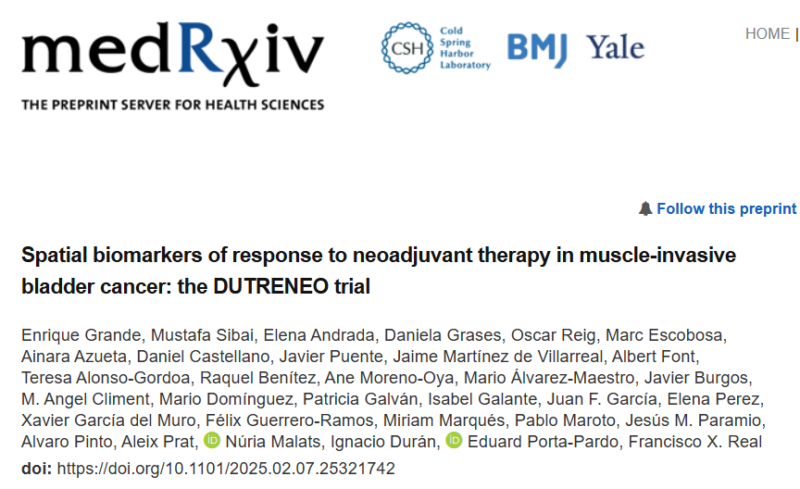
Enrique Grande: Spatial biomarkers of response to neoadjuvant therapy in muscle-invasive bladder cancer
Enrique Grande, Head of Oncology at MD Anderson Cancer Center, shared an article on LinkedIn he co-authored with colleagues about identifying spatial biomarkers to predict how muscle-invasive bladder cancer (MIBC) responds to neoadjuvant therapy.
Authors: Enrique Grande, Mustafa Sibai, Elena Andrada, Daniela Grases, Oscar Reig, Marc Escobosa, Ainara Azueta, Daniel Castellano, Javier Puente, Jaime Martínez de Villarreal, Albert Font, Teresa Alonso-Gordoa, Raquel Benítez, Ane Moreno-Oya, Mario Álvarez-Maestro, Javier Burgos, M. Angel Climent, Mario Domínguez, Patricia Galván, Isabel Galante, Juan F. García, Elena Perez, Xavier García del Muro, Félix Guerrero-Ramos, Miriam Marqués, Pablo Maroto, Jesús M. Paramio, Alvaro Pinto, Aleix Prat, Núria Malats, Ignacio Durán, Eduard Porta-Pardo, Francisco X. Real.

The DUTRENEO trial aimed to assess the predictive value of an 18-gene Tumour Inflammation Signature (TIS) for guiding treatment decisions in patients with localized muscle-invasive bladder cancer (MIBC).
The study explored whether the TIS score could stratify patients to receive either neoadjuvant immune checkpoint inhibitors (ICI) or standard cisplatin-based chemotherapy (NAC). Patients with TIS-high tumors were randomized to either ICI (durvalumab+tremelimumab) or NAC, while those with TIS-low tumors received only NAC. The trial involved 73 patients in total.
The results showed no significant difference in pathological complete response (pCR) rates between the groups: 38.5% for TIS-high receiving ICI, 30% for TIS-high receiving NAC, and 55% for TIS-low receiving NAC (p = 0.349). This indicated that, as applied, the TIS score did not effectively predict responders to ICI. Post-hoc analysis suggested that higher TIS thresholds improved response prediction but excluded many responders, highlighting the complexity of using retrospective biomarkers prospectively.
Further multi-omics analyses, including whole-exome sequencing, bulk RNA sequencing, and spatial transcriptomics, provided additional insights. These analyses revealed that response signatures primarily originated from cancer cells and that ICI response correlated with the proximity between cancer cells and immune cells. In contrast, resistance to NAC was associated with phenotypic plasticity in cancer cells. The findings emphasize the challenges of translating retrospective biomarkers into clinical practice and underscore the value of incorporating spatial and multi-modal biomarkers for better treatment stratification in clinical trials.
-
Challenging the Status Quo in Colorectal Cancer 2024
December 6-8, 2024
-
ESMO 2024 Congress
September 13-17, 2024
-
ASCO Annual Meeting
May 30 - June 4, 2024
-
Yvonne Award 2024
May 31, 2024
-
OncoThon 2024, Online
Feb. 15, 2024
-
Global Summit on War & Cancer 2023, Online
Dec. 14-16, 2023
